4. Refund policy: Have a policy, stick to it
What it says: “Not happy with the program? These and ONLY THESE are the terms under which I’ll give you your money back.”
What it does: Sets clear terms around when you do and do not offer refunds, so you’re protected against refunding people for whom you’ve already done the work.


Having a clear refund policy in place spares you having to agonize over whether to give a refund on a case-by-case basis.
Plus, if you cover it in your contract, and students sign off on that upfront, they know: they have 30 days (or 60 days, or 90 — you’re the business owner, it’s totally your call) to make a decision.


5. Rescheduling policy: Set clear boundaries upfront
What it says: “Life happens. I get it. But here’s what I need from you if you’re going to reschedule a coaching session.”
What it does: Sets clear expectations for students around how cancellations work, and what they need to do to reschedule their appointment with you.
Here’s what the rescheduling policy looks like in the Coaching Agreement for Scott Barlow’sbusiness, Happen to Your Career:
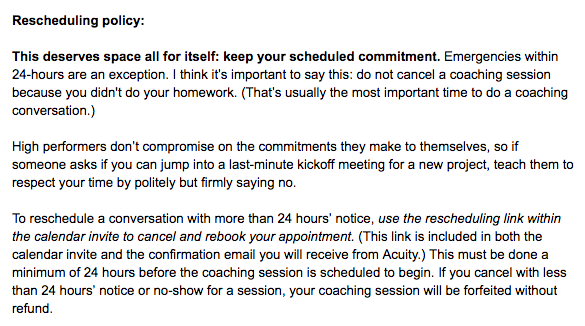

When students abuse the “reschedule” button, and it takes them weeks and months longer than it should to complete their program, not only does it throw your schedule into disarray, it potentially takes slots away that could be going to other clients. Clients who will show up. Clients who will pay.
A clear, firm rescheduling/cancellation policy nips that in the bud. It also eliminates the headaches from endless email back-and-forth trying to find another available time — a headache that’s felt on both ends.
6. Client responsibility: Help your clients help themselves
What it says: “I’ve put together an awesome program, but I’m not a miracle worker. This is your program, this is your time — if you want to get the most out of it that you can, you need to show up and do the work.”
What it does: Reminds students that in order to get the full benefit of the program, they need to be accountable for doing their part to make it a success.
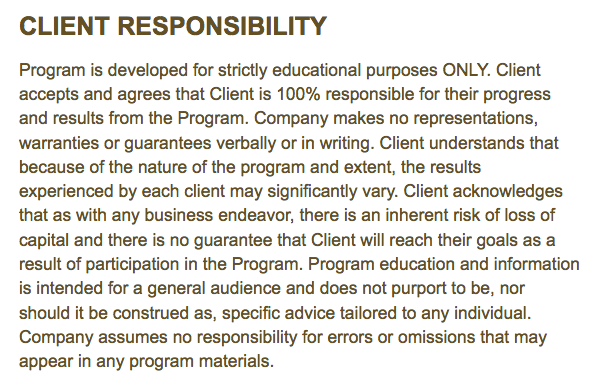

This is the tricky thing about coaching: the success of the program so often depends on what the student is ready to bring to it.
If you hold up your end of the bargain, deliver an amazing coaching program jam-packed with tools and insights, and then the client doesn’t hold up theirs, should you lose out on that payment? Heck no! The Client Responsibility section covers off that and lets students know upfront: if they want the results, they need to put in the effort.
7. Confidentiality: What happens in coaching stays in coaching
What it says: “Your information is yours, my information is mine. Let’s not either of us share the other’s information without permission.”
What it does: Protects you AND your client from information getting shared that you don’t want shared.
Coaching relationships are about trust. Your students are sharing sensitive information with you, from their payment info to their email address, to the details about their lives shared during sessions. They deserve to know that that information is taken care of.
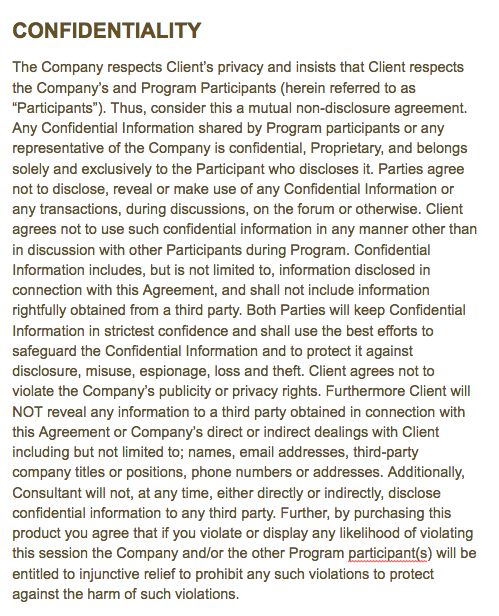

But that trust is a two-way street. Just as important as the expectation that you’ll protect your client’s info is the expectation that they’ll protect yours: specifically, the materials and exercises that you share with them as part of your program.
Copyright infringement is a real threat to information product entrepreneurs, and coaches in particular. Your students might not even realize that, by sharing a worksheet that you gave them, they’re potentially infringing on your intellectual property.
Covering off this information early can prevent crossed signals and bad feelings, and ensure that you and your clients are on the same page about what’s shareable material — and what isn’t.
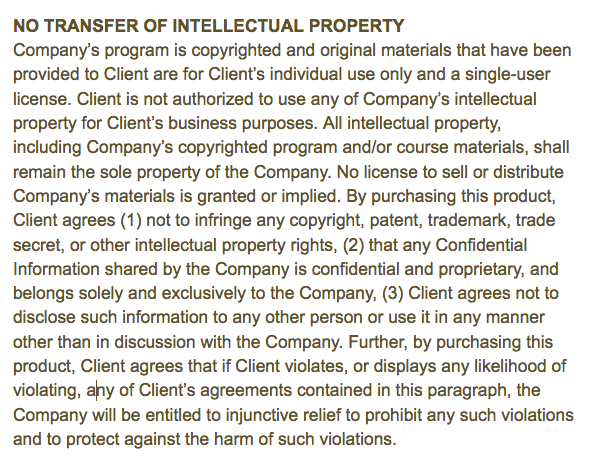

8. Termination: Like a prenup for your business
What it says: “I want you to get the most out of this program that you can. But I reserve the right to fire you as a client.”
What it does: Gives you a legal “way out” in the event that you need to part ways with a particularly toxic client.


This is the “nuclear option” of the coaching world: you should really only break up with clients if the feeling is mutual, or if you know deep down to the core of your coaching soul that there’s nothing you can do to help them.
9. Indemnity: The CYA clause
What it says: “Look, sometimes things don’t go right. Let’s settle things like level-headed adults and not like … overly litigious adults.”
What it does: Protects you against legal liability in the event something should go really wrong.
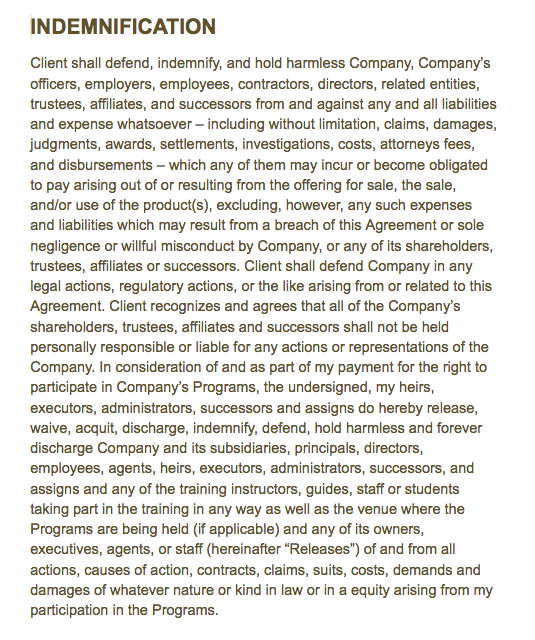

Call this the “shit hits the fan” section of the contract. It’s the section that covers what will go down if the absolute worst should occur: like if a client refuses to pay for their sessions, or if they sue you.
Note: Most of the sections we’ve gone over are things that you can draft yourself. But the indemnity clause is one where it really is worth your while to have a legal professional look it over, just to make sure it covers all the bases that it needs to cover to hold up in court.
Are you short on legal help these days? Here’s a list of lawyer organizations that provide pro-bono legal services.
So what now?
Now you have all the information you need to start framing out the very first version of your coaching contract.
What happens after you create your contract? You’re ready to start sending it! No need to freak out over what software platform is best for contract record-keeping right now — Amanda sends her contract to clients via email and just asks them to send her an email letting them know they got it.
Remember: It doesn’t have to be perfect. It just has to work. There will be plenty of opportunities to revisit and refine your contract. In fact, you should plan on revisiting your contract every time you take on a new client or open a new round of coaching.
So for now, go ahead: open up a Google Doc (or copy our template of Amanda’s contract, found here). Label it “Coaching Contract v.1” or something like that, and create a subhead for each of these categories.
Then, start framing out:
- Introduction. What did this person just buy from me? What do I expect them to do with this contract?
- Disclaimer. What services am I not able to provide within the context of this program? What promises am I not able to make?
- Payment. How do I expect students to pay for the coaching they receive?
- Refund policy. How am I going to handle it when people want their money back?
- Rescheduling policy. How am I going to handle it when clients say they can’t make their appointment and want to reschedule?
- Client responsibility. What do my coachees need to do to hold up their end of this bargain?
- Confidentiality. What promise do I want to make to my coachees about their private information, and what do I expect from them in return?
- Termination. Under what terms do I consider this contract to be null and void?
- Indemnity / Limitation of Liability. If the worst-case scenario happens, how am I protected?
Coaches, we want to hear from you: How did you put together your first coaching contract? Is there a section of your coaching contract that you’d be lost without? What do you WISH you’d included in the first version of your contract, but didn’t? Share your thoughts in the comments below!


